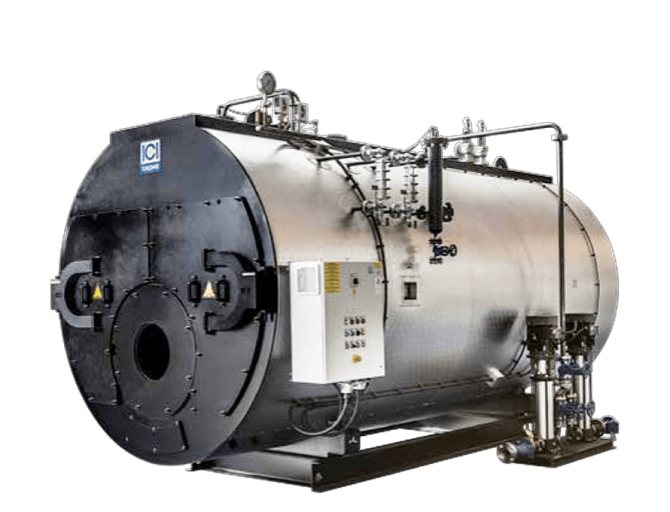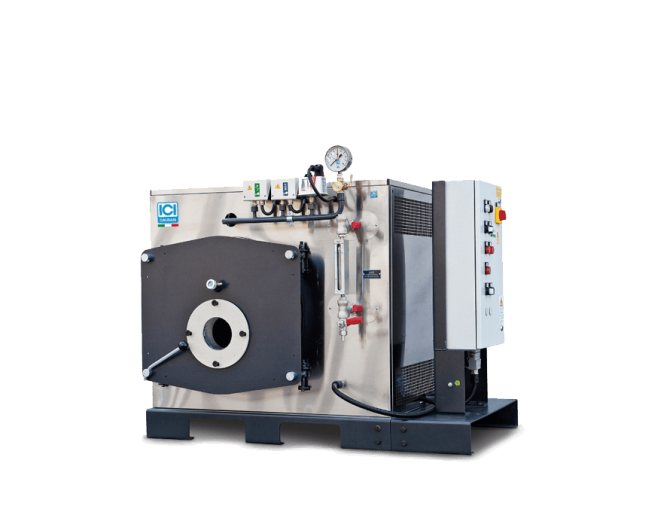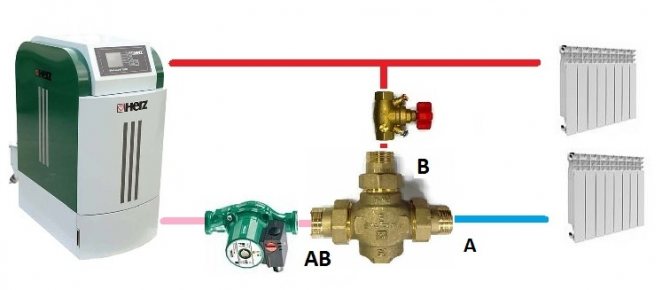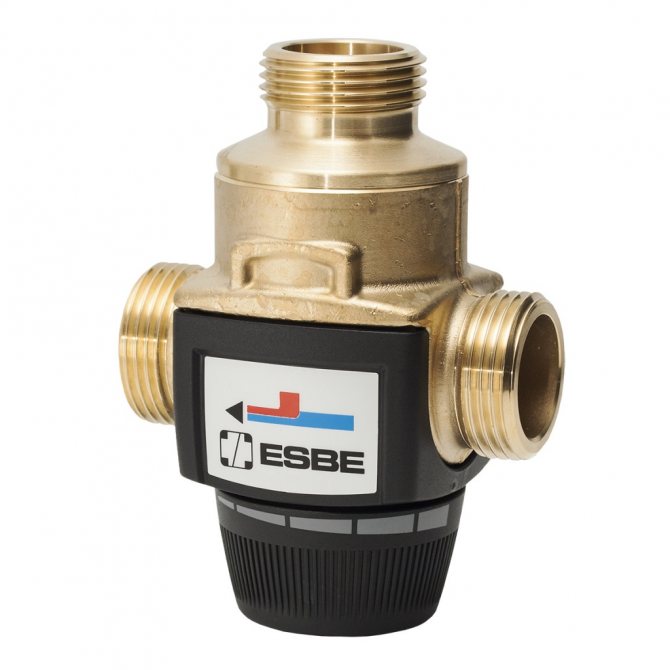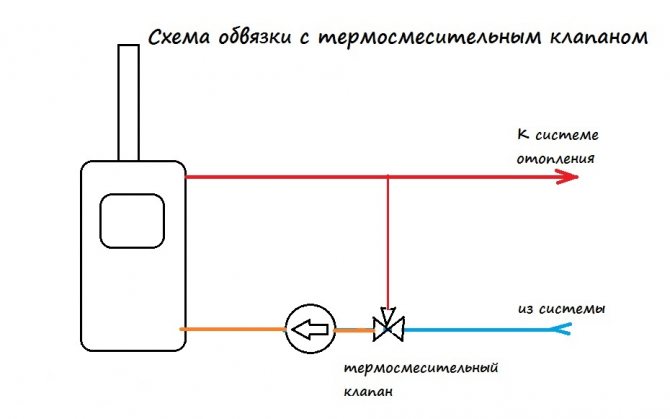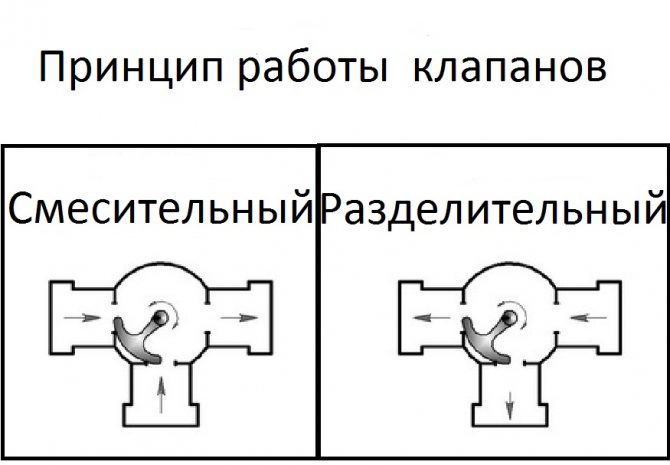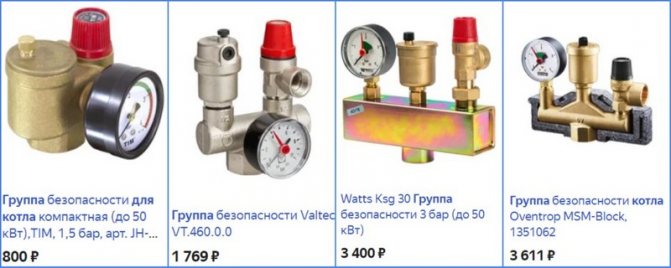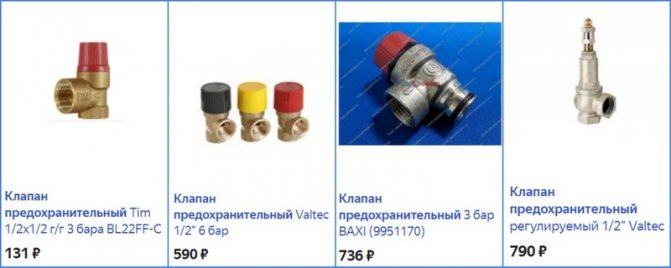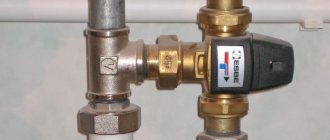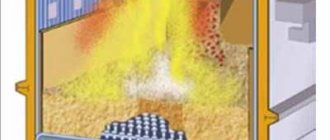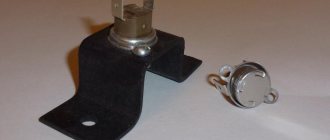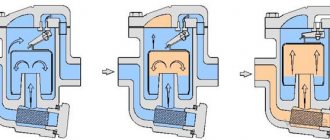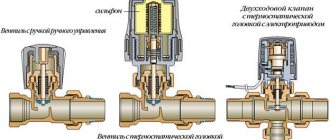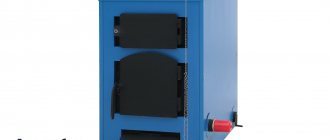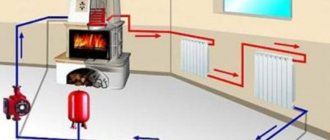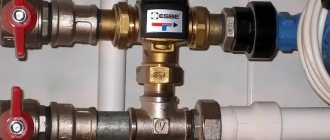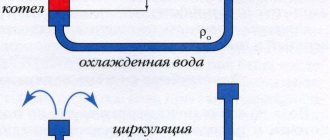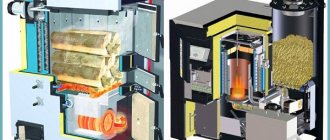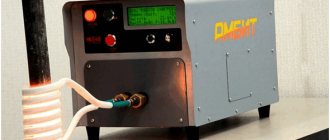The device and principle of operation of the three-way valve for the boiler
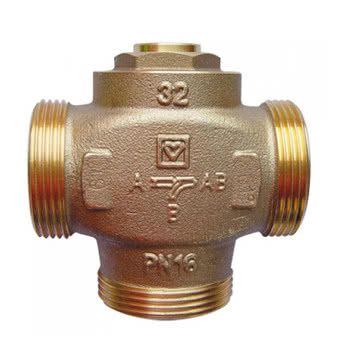
Three-way valve that regulates the temperature of the coolant in solid fuel boilers
The design device of a thermo-mixing valve for a solid fuel boiler or other may differ significantly depending on the purpose of the element and the manufacturer, but the principle of operation remains unchanged. The thermostat has three outputs: one of them is always open, while the others overlap completely or partially during operation. According to the number of outlets, the valve is called 3-way. It is used for mixing or dividing flows of liquid or gas, whereby the temperature of the coolant is regulated, switching from one circuit to another.
It looks like a tee. The internal device is represented by a locking mechanism and a rod, which ensures its movement - these are the main elements. Some designs have two seat rings to secure the valve. Supplementation with other elements is possible.
Renovation and reconstruction
Boilers that have been in operation for 15, 20 and more years have a natural process of wear and tear of equipment, efficiency decreases, the level of automation does not meet modern requirements. These and other reasons make the question of the reconstruction of such installations rational and economically justified.
For the repair and reconstruction of boiler houses we offer:
- development, together with the customer, of the Terms of Reference for the reconstruction;
- development and approval of the reconstruction project;
- replacement of outdated equipment with new, optimal in terms of price-quality ratio;
- conversion of boilers from one type of fuel to another, more economical and efficient;
- installation of modern automated burners of any type;
- installation of modern automation and control equipment;
- installation of new membrane expansion tanks;
- replacement of outdated water treatment systems with new, modern, automated systems;
- installation of modern metering devices for the consumption of electricity, gas, water and heat;
- installation of gas contamination sensors and fire and security alarms;
- creation of a remote operator station with the ability to remotely control the operation of the installation without the constant presence of maintenance personnel;
- training of the Customer's employees in the peculiarities of servicing the equipment of the updated, reconstructed boiler house.
Practice shows that as a result of reconstruction, the heat production of the renovated boiler house can increase up to 20%. The warranty period for works is 2 years.
Varieties of valves
The functionality of the valves is different. On this basis, three-way valves are divided into switching, mixing and separating.
Mixing
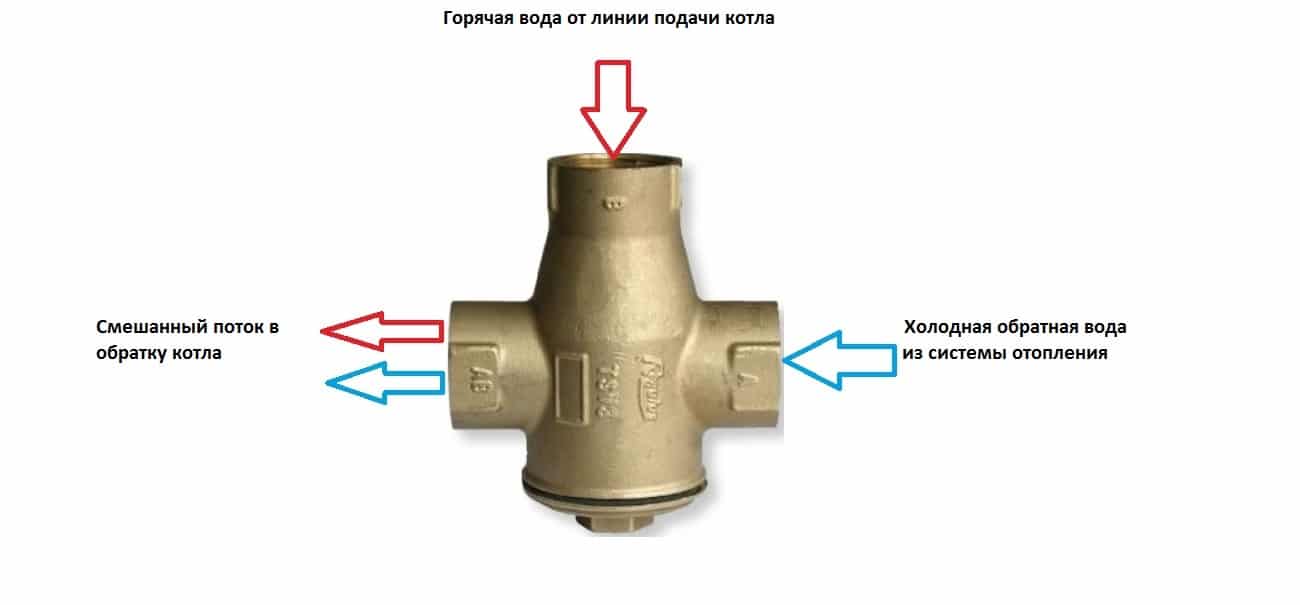

The principle of operation of a three-way valve in a heating system
A cold stream is supplied to one inlet, a hot stream to the other. At the outlet, they mix, forming one stream of a given temperature. Thus, thanks to the thermo mixer, the temperature of the coolant is regulated, in particular, the return flow is mixed into the coolant at the outlet of the boiler. For this, the valve is installed on the return pipe of the heating pipe.
Dividing
Isolation valves are also called control valves. They split one stream into two. They are used in the hot water supply system, piping of air heaters.
Switching
Changeover or changeover switches are used for switching from one circuit to another, for example from heating to hot water supply.Switching is carried out using an electric drive.
Three-way valve control methods
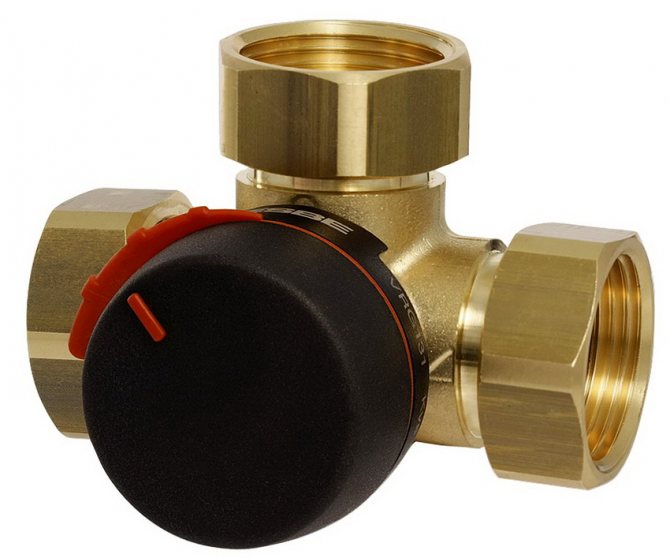

Three-way valve with thermostatic head
Three-way valves according to the control method are:
- autonomous;
- manual;
- thermostatic;
- with an electric drive.
If there is no control possibility, the thermal valve is of a self-contained type. It is preset by the manufacturer to a certain temperature of the heat carrier, i.e. the temperature in the system will always be constant. The main advantages of such devices are low cost and the ability to maintain the same temperature. But it is impossible to change the preset settings, so the characteristics of the valve must meet the requirements of the system, it will have to be selected more carefully.
The manually operated 3-way valve is equipped with a manual adjustment device such as a control panel, rotary knob or valve. Control of adjustment is carried out using special marks - a scale. Compared to a stand-alone regulator, the manual three-way thermal valve is more functional: it allows you to change the temperature mode depending on specific needs and will maintain the temperature at a given level. However, this valve "does not know how" by changing the temperature of the coolant to the transformation of the surrounding conditions.
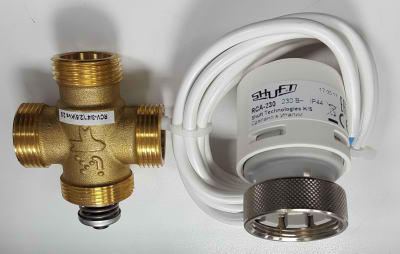

Electrically operated valve
The design of the product with a thermostat includes a thermostat. The gaseous or liquid medium inside it reacts to changes in the temperature of the coolant. When it heats up to the preset temperature, the hot water pipe is closed off. By the type of power supply, this type of valve can be mechanical and electronic. Mechanical ones work autonomously, while electronic ones require a power supply or periodic battery replacement. Although this inconvenience is fully offset by the benefits.
The inclusion of a thermostatic valve for a solid fuel boiler into the system allows you to automate the process of changing the temperature regime according to the time of day, days of the week. The cost of a three-way element with a thermostat is higher than the cost of simpler analogs.
The most advanced models are electrically actuated thermal valves. In order for their work to be constant, it is necessary to install an uninterruptible power supply unit. The flow of cold or hot heat carrier is regulated by a controller, which registers temperature deviations from the set values, and a servo drive. The outlets do not completely overlap, but the volume of the coolant changes. Thanks to the operation of the automation, the heating circuit is always evenly warmed up, and the temperature of the coolant always exactly matches the set one. The ability to change the mode is also present, but you need to be prepared for a high consumption of resources: coolant and electricity. You will have to pay more for the thermal valve itself. A fully automatic device is more expensive.
Purpose and functions
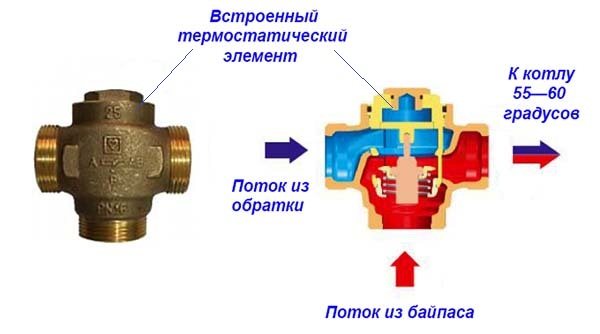

Mixing of flows is necessary so that condensate does not form in the boiler due to cold return
The three-way valve is installed for the following purposes:
- So that the cold coolant does not succumb to the boiler and condensate does not fall out on the inner walls of the furnace. In addition, if a cast iron heat exchanger is used in a hot water boiler, it may crack from temperature changes.
- To regulate the temperature of the coolant in the circuits. This need may be due to the complexity of the system, where the temperature requirements for each circuit are different. When connected to a heat accumulator, as well as when the heat carrier is used in the heat exchanger of the air handling unit, which is part of the air heating system.
- To be able to control the heating of the coolant in the underfloor heating circuit. The optimum temperature for underfloor heating is no more than 50 ° C. The temperature of the coolant coming from the boiler can exceed this figure by 10-35 ° C. The cooled water that has passed through the underfloor heating circuit will mix with the coolant from the boiler, a three-way valve installed on the distribution manifold will mix the return flow.
The regulator should not be installed if several heating sources operate in the system one by one; if the length of each loop of the water floor is no more than 50-60 m (then RTL heads are installed instead of a three-way valve); if the heating is organized according to a gravity system.
Types of fire tube boilers
Fire-tube steam boilers are subdivided into the following types according to the type of heating medium:
- steam rooms, in which steam is used for heating, accumulated in a separate special tank;
- hot water, using water to heat the coolant, the use of steam is unacceptable due to the need to prevent overheating and deformation of the walls of the boiler body.
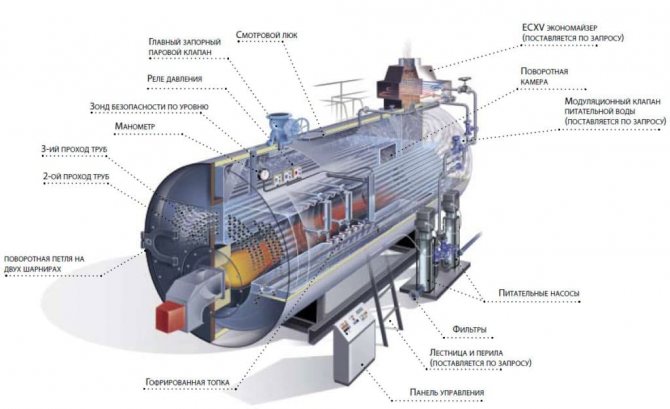

Diagram of a hot-water fire-tube boiler
Basic parameters when choosing valves
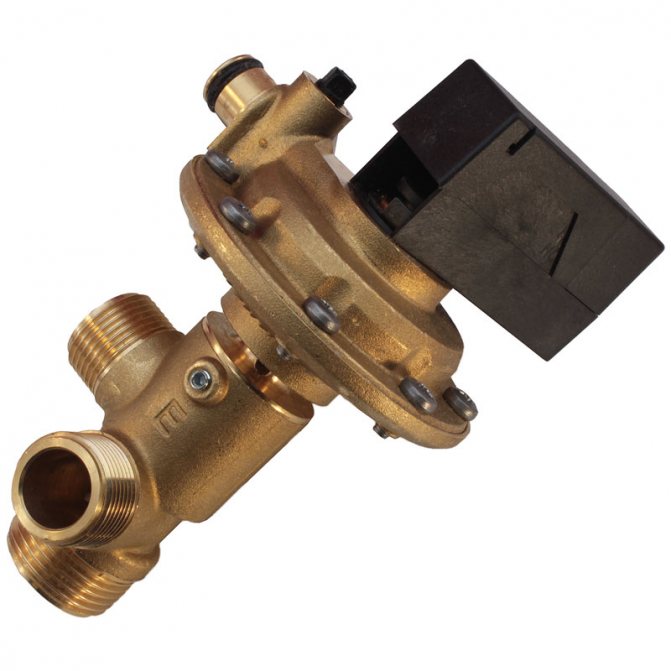

Brass products have an increased service life, do not crack due to mechanical stress
The three-way valve should correspond to the features of the system as much as possible, therefore, when choosing, all parameters should be checked: design device, technical characteristics.
- First of all, it is necessary to cut off options that are made of unsuitable metal. Silumin low-cost three-way valves are eliminated immediately, since the aluminum-silicon alloy is of low strength. Such thermal valves crack and literally crumble during operation.
- Cast iron 3-way valves do not corrode and are strong enough under static loads, but a point mechanical impact or a sharp temperature drop can cause it to break. Such devices cannot be repaired.
- Steel devices are inexpensive and durable at the same time, but they rust over time. In order to protect against corrosion, the products are coated with nickel and chromium.
- Thermal valves made of stainless steel are more expensive, the metal is not subject to oxidation and corrosion, so they will serve for a long time.
- Brass and bronze 3-way valves are preferred because the material best meets the requirements for durability and corrosion resistance. Brass products cannot be installed in a system where the coolant is heated to temperatures exceeding 200 degrees. Bronze devices are built into a heating circuit made of copper.
The internal locking mechanism in some products may be ceramic. If the operating conditions are observed, ceramics perform in the best possible way: they do not rust and serve for a long time. But the coolant in the system must be of high quality. In the presence of mechanical impurities, ceramic elements will quickly fail.
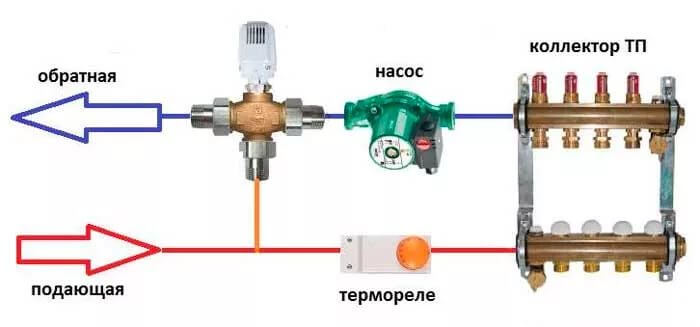

For underfloor heating, it is preferable to install valves with a servo drive
The type of valve is selected taking into account the characteristics of the system:
- To protect the boiler from condensation, a valve with an internal thermostat set to a constant temperature of the heating medium is sufficient.
- If the system consists of several branches and it is necessary to control the heating of each, a regulator with a thermal head and a remote sensor is installed.
- When self-assembling the system, a mixing valve is recommended for installation. It is easier for a beginner to understand the scheme of its work, how to put it, remove it.
- Saddle types, in contrast to rotary ones, more accurately allow you to regulate the temperature of the coolant and the pressure.
- For underfloor heating, electric models with a servo drive are recommended.
- For DHW - dividing valves, for heating - mixing valves.


The diameter of the thread on the valve must match the diameter of the heating pipes
As for the technical characteristics, it is necessary to take into account:
- connection method - it can be threaded and flanged;
- inner diameter of pipes - must match the diameter of the pipes at the installation site;
- maximum working pressure;
- the maximum temperature of the coolant at the installation site;
- average water consumption per hour - conditional throughput;
- dynamic range of regulation (30: 1, 50: 1, 100: 1) - indicates the difference in throughput when the valve is fully closed and half open.
Valves with a range of 100: 1 offer a wider range of adjustments.
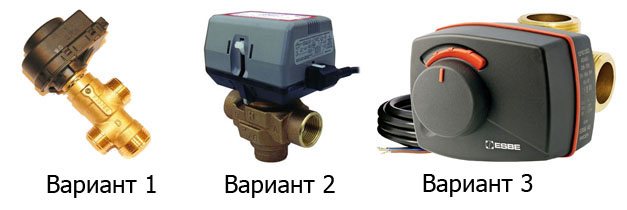

Models depending on the volume of the heating medium, ESBE brand
The data is indicated in the passport for the product. In order to correctly select the valve according to the parameters of the system, it is also necessary to calculate the flow rate of the coolant in the installation line, because the valve must pass the required volume of water at different positions of the stem.
Last but not least, the parameter is the manufacturer. Popular:
- Esbe (Sweden);
- Danfoss (Denmark);
- Honeywell (USA);
- Herz Armaturen (Austria);
- Caleffi (Italy);
- Icma (Italy);
- Valtec (Russia).
It is recommended to choose products of well-known brands, then you can be sure that the marking and the declared characteristics correspond to the real parameters of the three-way valve.
Reasons that may result in overheating of a solid fuel boiler
Even at the stage of selection and purchase, it is important to take into account the operational characteristics of the heating device. Many models that are on sale today have a built-in overheating protection system
Whether it works or not is the second question. However, it is necessary to adhere to certain knowledge and skills, hoping to create an efficient and safe autonomous heating system at home.
The reliable operation of the heating unit depends on the operating conditions. In case of obvious violations of the technological parameters of heating equipment and abuse of standard safety rules, there is a high probability of an emergency.
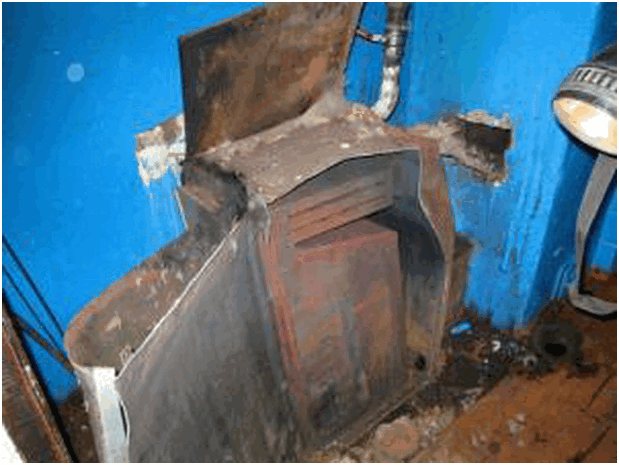

Possible negative consequences can be prevented even at the stage of installing a solid fuel boiler. Correct piping of the heating device will guarantee your safety and reliable operation of the unit in the future.
In detail, in each case, the solid fuel boiler protection system has its own specifics and features. Each heating system has its own pros and cons. For instance:
When it comes to solid fuel boilers with natural circulation of the coolant, it is necessary to take care of the safety and operability of the heating equipment even during installation. The pipes in the system are installed metal. Moreover, the diameter of such pipes must exceed the diameter of the pipes used for laying a circuit with forced circulation of the coolant. Sensors installed on the water circuit will signal a possible overheating of the coolant. The safety valve and expansion vessel act as a compensator, reducing overpressure in the system.
A significant disadvantage of the gravitational heating system is the lack of an effective mechanism for adjusting the operating modes of solid fuel boilers.
Large technological opportunities for consumers are provided by those working with forced circulation of the coolant in the system. Already only the presence of the second circuit significantly increases the ability to regulate the heating temperature of the boiler water. The only drawback in the operation of such a system is a working pump, which can make it difficult to operate the heating system with its work.
This is due to the fact that when the electricity is cut off, the pump stops performing its functions. The stoppage of the circulation process and the inertia of solid fuel heating boilers can lead to overheating of the heating unit.If the boiler equipment is not equipped, the situation with a power outage is fraught with extremely unpleasant consequences.
Effective protection against overheating of a working solid fuel boiler should be based on the mechanism for removing excess heat generated by the heating device.
Simplified budget items


Cheap models made of silumin have low strength and are damaged during operation.
Three-way valves of a stand-alone type are considered to be simplified. Their internal structure is really simplified, since neither a thermal head with a controller nor a stem is provided in them. The thermostatic element is installed inside and designed for a specific temperature (often 50 ° C or 60 ° C). It will not be possible to change the settings, the flow temperature at the outlet from the valve will always correspond to the set ± 2 ° С. This option is for those who install the valve in simple heating systems and want to save money. The cost of simplified elements is about 30% lower than the average cost of the bulk of regulators.
The thermostatic three-way valve is necessary in complex systems that include several circuits: hot water supply, heating, underfloor heating. It allows you to save fuel by using the heat energy generated by the boiler more efficiently. Despite the many advantages, the installation of the valve is not always justified, therefore, you should consult with a specialist regarding the advisability of installing it.
Training
Buyers' employees can undergo training in the maintenance of boiler houses produced by "Alliansteplo". Although all systems of our boiler houses are automated and do not require the constant presence of maintenance personnel, there are always subtleties and peculiarities in the maintenance of specific equipment. In the process of commissioning and commissioning, our specialists will tell you in detail and in detail about the features of boiler house maintenance, explain and show what to do in case of non-standard situations and how to best maintain normal operation.

